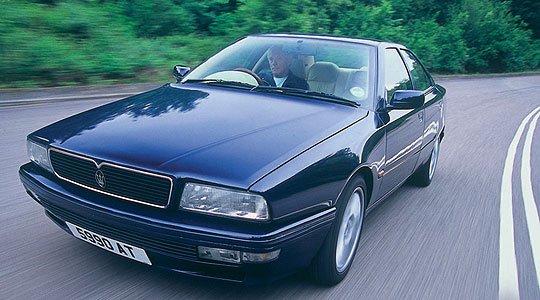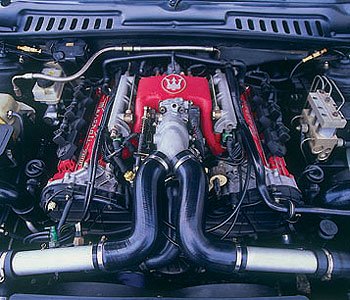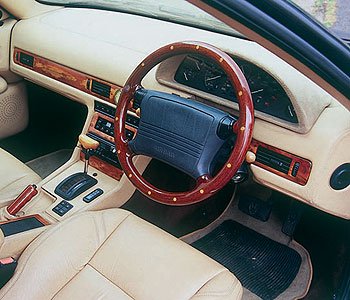
The following is an extract from Simon Park's feature in Auto Italia magazine, Issue 124 2006. For access to the full feature, plus articles on the Alfa Romeo Brera Q4 V6, Maserati Quattroporte IV, Alfa Romeo exotica such as the Tipo 33 concept cars, a review of the 2006 Le Mans Classic and much more, see www.auto-italia.co.uk
When Alessandro De Tomaso finally threw in the Trident-branded towel in 1993, selling his entire holding in Maserati to Fiat, the new proprietors very quickly set about planning a replacement for the Argentinean’s brawny flagship – something altogether more modern and agile. The Quattroporte IV bowed in at the 1994 Turin Show.
Marcello Gandini had come up with a design far more lithe, sinewy and compact than any of its predecessors. Taut and elegant from any angle, it was also the most aerodynamic. The kicked-up rear wheelarch is to Gandini what the double-bubble roof is to Zagato – a stylistic calling-card which, for my money, looks better on his more extreme machines such as the Lancia Stratos Zero, or the Lamborghinis Countach, Bravo and Diablo. That idiosyncrasy aside, there’s no excess fat, no rococo adornment, and the result is the most elegant package ever to grace the Biturbo underpinnings. We have also gone, at a stroke, from the largest Quattroporte to the smallest.
And to the quickest, by far – up to that point. Both of the versions offered initially in the new QP – even the Italian market-only 2.0-litre tax-break special – could trump the QPIII’s 4.9-litre V8 in that respect. And they had well over 300kg less to pull. In fact, the well-boosted two-litre version trumped the alternative 2.8 as well (by 3bhp), but the bigger unit boasted an effortless driveability more in keeping with the QP ethos. And those who felt that this demanded no fewer than eight pots were well catered for by the 3.2-litre V8 – ‘Ottocilindri’ – introduced as an option two years after the car’s debut, in 1996. With 335bhp to play with the QPIV really could rock – sub-six seconds 0-60 and 170mph were well up with the best of the German autobahn-burners.
In 1997, Fiat handed control of Maserati over to fellow-subsidiary Ferrari, who took one look at its erstwhile rival’s antiquated factory, had a good laugh – and closed it down for major refurbishment. With production disrupted, the opportunity was taken to completely re-vamp the QP – although the major mechanical components were untouched – and re-introduce it, in 1998, alongside the new 3200GT. Now branded ‘Evoluzione’ it remained in production, with all three engine options, until 2001.


When the last of them rolled off the line our test car was five years old. A 2.8-litre ‘Seicilindri’, with ZF on hand to change gear for you, it’s now 10, has 115,000 miles to its credit, and feels and looks to all intents and purposes like a new car. The seats are as good as they look, legroom in the back is okay, but the whole interior is rather ‘cosier’ than the cavernous expanses of the QPIII. The general ambience is one of impeccably tasteful, if slightly decadent, luxury.
The QP’s tolerance of traffic was far better than mine in fact, and I was glad to reach the track, and of the chance to stretch its legs. They stretch with disconcerting ease, too, the wild surge of acceleration something of a shock initially, after all the pootling about. The two IHIs go about their business with no detectable lag, and the svelte saloon turns almost feral. The V6 has a diamond-hard sound at full stretch, although it’s not especially characterful. There’s a little wind noise at high velocities, but overall it’s an extremely refined drive. And no QP ever went like this before – the V8 being significantly quicker still, of course.
There are no ‘steps’ in the power delivery, just a linear surge barely interrupted by the 4-speed auto’s ultra-smooth, unobtrusive changes. In Drive, the natural change-up point is around 5k, but taking over and changing manually brings about a transformation. Response to the lever is super-quick and, using all your allotted 6400rpm, second and third are long, meaty ratios which make the most of the motor’s wide power band. You can commit to corners, in particular, with a lot more confidence knowing the ’box won’t decide to help itself to another cog at an inconvenient moment.
All in all, not half bad for a once-round-the-clock workhorse. So why did the QPIV not perform equally well in the showroom? Conventional wisdom has it that its ‘Italian flare’ appealed to ‘arty, media types’ and ‘individualists’ (all the usual buzzwords) who nursed a stubborn, cultural aversion to being seen near anything German; but sensible punters, of course, would always go shopping north of the Alps.

And that’s about the only thing Maserati got wrong – not moving two or three hundred miles north and changing its name to MMW. Everything else was pretty much spot-on, and the ‘IV’ represents a quantum leap forward from previous QPs. The big breakthrough, though, would come with its successor – a car of sufficient quality in every area finally to challenge the Anglo-Saxon super-saloon hegemony. Watch this space.
|
Words by Simon Park and pictures courtesy of Michael Ward.
See www.auto-italia.co.uk or call +44(0)1858 438817 for back issues and subscriptions. |
ClassicInside - The Classic Driver Newsletter
Free Subscription!





